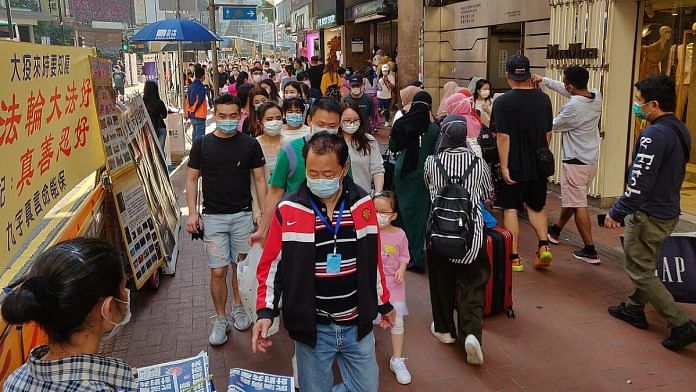But in some parts of Asia, the surge in cases has led to concerns.
According to a government bulletin issued in Singapore last week, the first such bulletin released in almost a year, the estimated number of cases in the week of 27 April to 3 May, 2025, stood at 14,200 cases, compared to 11,100 cases the previous week. Also, over the same period, the average daily COVID-19 hospitalisations rose from 102 to 133.
In Hong Kong, according to the official update, a total of 1,042 COVID-19 cases were recorded in week 19 (May 4-10) of the year, up from 972 in the preceding week. “The latest surveillance data showed that the overall local activity of COVID-19 has continued to increase, with some surveillance indicators such as the positive detection rate of respiratory specimens tested positive for SARS-CoV-2 virus and sewage viral load having surpassed their highest levels in the past 52 weeks,” the update said.
According to publicly available information, the dominant SARS-CoV-2 variants in both countries are subvariants of JN.1—a sub-lineage of the BA.2.86 omicron variant first seen in Denmark in July, 2023. JN.1 was the last prominent dominant variant responsible for a significant surge in various countries including the US over a year ago.
The omicron variant of SARS-Cov-2 was behind the last significant (third) wave of the COVID-19 pandemic in India after alpha and delta variants earlier.
According to the World Health Organisation (WHO)’s latest assessment, there is no cause to worry. “Considering the available evidence, the additional public health risk posed by JN.1 is still evaluated as low at the global level,” the WHO said earlier this month.
This variant, according to the global health agency, has been seen across all of its regions and seems to have a growth advantage over previously circulating variants, indicating it can transmit at a faster rate, though the factors behind this ability are not fully understood.
A virologist with the Indian Council of Medical Research-National Institute of Virology (ICMR-NIV) explained that there does not seem to be any remarkable difference between current sublineages of JN.1 when compared to its cousins that had been circulating over the last few years.
“There is no reason for alarm bells to ring on the basis of some spike in cases unless we notice a significant rise in hospitalisations or disease severity,” said the virologist who did not wish to be named.
The current surge in infections in some parts, he also, could be explained by waning immunity as most people are not taking repeated booster shots against the infection. “Despite this, what we need to remember is that there is no evidence of our body’s neutralisation capacity—the immune system’s capacity to kill the virus—going down against the mutated virus.”
Clinicians, too, agreed. Dr Sandeep Budhiraja, group medical director with Max Healthcare & senior director at the Institute of Internal Medicine, underlined that people need to understand that despite the pandemic being over, the COVID-19 virus is now part of our surroundings.
“Once the peak pandemic stage is over, viruses tend to remain in more endemic form and periodically have a tendency to cause these outbreaks which could be limited regional outbreaks or may develop a potential to spread to a larger area and cause a bigger outbreak,” he said.
This, according to him, is not because the virus is more virulent but probably to do with waning immunity of the population at large, especially since now that routine vaccinations have not been happening. “What we know of various JN.1 sub variants belonging to the Omicron family is, they do not cause a serious or severe illness in most people.”
But these subvariants are highly infectious and spread fast in a community, region or a country. In very high-risk individuals, people of old age, those who are immunocompromised, and with various medical comorbidities, virus is likely to lead to serious and sometimes fatal disease,” he said.
The government said a robust system for surveillance of respiratory viral illnesses including COVID-19 exists through the Integrated Disease Surveillance Programme (IDSP) and ICMR. It added that the health ministry was vigilant and proactive in monitoring the situation closely, ensuring appropriate measures are in place to safeguard public health.
Public health specialist Dr Sameer Bhati cautioned high-risk individuals to go back to standard preventive measures such as masking in crowded indoor areas, hand hygiene, and avoiding unnecessary exposure to high-risk settings. “Also, people should stay home when unwell, and being vaccinated or boosted, are essential. At the same time, India needs to maintain high levels of genomic surveillance, awareness, and awareness of any contingency healthcare practice planning,” he underlined.
The country, said experts, should remain on vigil and alert to any unusual rises in numbers of flu-like illnesses and severe cases.
At this stage, other than maintaining a vigil and continuing with genomic surveillance, any mass advice for people at a larger population base is not required because India has yet not reported any increased number of cases, Budhiraja said.
Bhati stressed that while the COVID-19 virus seems to be evolving in a more predictable direction, our response must remain flexible and based on a data-informed approach.
(Edited by Amrtansh Arora)






![[WATCH] IPL 2025: Vaibhav Suryavanshi touches MS Dhoni's feet post winning clash vs CSK](https://eflip.in/wp-content/uploads/2025/05/1747763070972_ms-dhoni-and-vaibhav-suryavanshi-150x150.jpeg)

